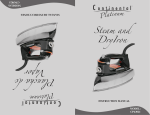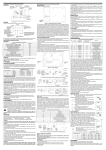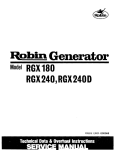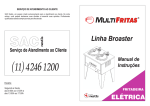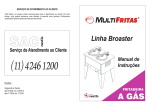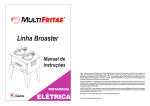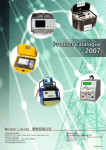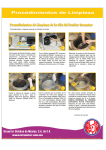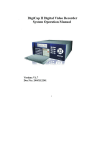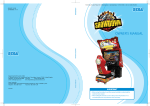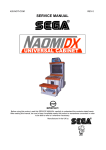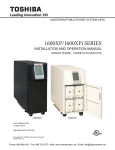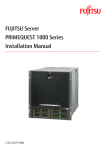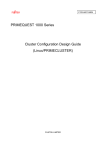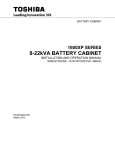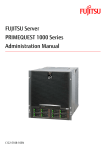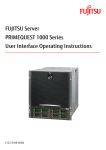Download Service Manual 09/2008
Transcript
“An American Tradition Since 1954!” MODEL 1600 AND 1800 BROASTER® PRESSURE FRYER SERVICE MANUAL Be sure ALL installers read, understand, and have access to this manual at all times. Broaster®, Broasted®, Broasted Chicken®, Broaster Foods®. and Broasterie® are registered trademarks. Usage is available only to licensed opertors with written authorization from The Broaster Comany. The Broaster Company 2855 Cranston Road, Beloit, WI 53511-3991 608/365-0193 - www.broaster.com Design Certified By: Printed in U.S.A. 1600: CSA, NSF and UL 1800: CSA (AGA & CGA), NSF and UL 14680 3/99 Rev. 9/08 Copyright 1999 The Broaster Company FOR YOUR SAFETY Do not use or store gasoline or other flammable vapors or liquids in the vicinity of this or any other appliance. WARNING: Improper installation, adjustments, alteration, service or maintenance can cause property damage, injury or death. Read the installation, operating and maintenance instructions thoroughly before installing or servicing this equipment. For the sake of safety and clarity, the following words used in this manual are defined as follows: DANGER: Indicates an imminently hazardous situation which, if not avoided, could result in serious injury or death. WARNING: Indicates a potentially hazardous situation which, if not avoided, could result in serious injury or death. CAUTION: Indicates a potentially hazardous situation which, if not avoided, could result in minor injury, property damage or both. All adjustments and repairs shall be made by an authorized Broaster Company representative. If there is a power failure, turn cook/filter switch OFF. On the Model 1800GH, also slide switch on gas valve OFF. DO NOT attempt to operate unit during a power failure. 1800GH: Post, in prominent locations, instructions to be followed in the event that the user smells gas. This information can be obtained from your local gas supplier. WARNING: Failure to read and understand this manual completely could result in serious injury or death. Be sure ALL operators read, understand and have access to this manual at all times. WARNING: 1600 Mechanical Controls: If at any time the unit fails to operate properly when the cook/filter switch is moved to the cook position, contact your local Broaster Company representative for service immediately. 1600/1800E Solid State Controls: If at any time the POWER ON light does not turn off when the cook/filter switch is moved to the OFF position, contact your local Broaster Company representative for service immediately. WARNING: Rags or papers containing cooking oil can catch fire if exposed to heat. Laundering will not remove the oil. Dispose of all oil-soiled papers and rags in a trash container that is in a ventilated area away from all cooking equipment or other heat sources such as direct sunlight. Manual #14680 3/99 Rev: 3/06 TABLE OF CONTENTS 1 - WARNING SIGNS....................................................................................................... 1 - 1 1600.......................................................................................................................... 1 - 1 1800.......................................................................................................................... 1 - 4 2 - ELECTRIC POWER SUPPLY..................................................................................... 2 - 1 WIRING DIAGRAMS Single and Three Phase Power Connection ....................................................... 2 - 1 DOMESTIC: 1600 Mechanical............................................................................................ 2 - 2 1600/1800E Solid State ................................................................................. 2 - 5 1800GH ....................................................................................................... 2 - 11 EXPORT: 1600XP/1800EXP Mechanical..................................................................... 2 - 12 1600XP/1800EXP Solid State...................................................................... 2 - 15 1800GHXP................................................................................................... 2 - 18 EU: 1600CE Mechanical..................................................................................... 2 - 19 1600CE/1800ECE Solid State ..................................................................... 2 - 20 1800GHCE .................................................................................................. 2 - 21 United Kingdom: 1600UK/1800EUK ....................................................................................... 2 - 22 1800GHUK .................................................................................................. 2 - 23 3 - 1600 MECHANICAL CONTROL PANEL.................................................................... 3 - 1 FAMILIARIZATION ................................................................................................... 3 - 1 ACCESS FOR SERVICE ......................................................................................... 3 - 2 INDICATOR LIGHTS ................................................................................................ 3 - 3 COOK/FILTER SWITCH AND POWER ON SWITCH.............................................. 3 - 3 TIMER ...................................................................................................................... 3 - 4 HI-LIMIT.................................................................................................................... 3 - 5 THERMOSTAT ......................................................................................................... 3 - 6 #14680 3/99 Rev 4/08 4 - SOLID STATE CONTROL PANEL ............................................................................. 4 - 1 ROTARY DIAL FAMILIARIZATION........................................................................... 4 - 1 CONTROLLER PROGRAMMING ............................................................................ 4 - 2 DUAL DISPLAY FAMILIARIZATION......................................................................... 4 - 3 CONTROLLER PROGRAMMING ............................................................................ 4 - 4 PRESET PROGRAMMING ...................................................................................... 4 - 5 WARNING DISPLAYS .............................................................................................. 4 - 6 DISPLAYING ACTUAL TEMPERATURE ................................................................. 4 - 7 CALIBRATION.......................................................................................................... 4 - 7 ACCESS FOR SERVICE ......................................................................................... 4 - 8 COOK/FILTER SWITCH........................................................................................... 4 - 9 HI-LIMIT CONTROL ................................................................................................. 4 - 9 POWER ON INDICATOR LIGHT ........................................................................... 4 - 11 SOLID STATE CONTROLLER ............................................................................... 4 - 11 TEMPERATURE SENSOR PROBE....................................................................... 4 - 12 5 - POWER INPUT BOX .................................................................................................. 5 - 1 1600/1800E CONTACTORS (1600/1800E) ............................................................................ 5 - 2 FUSE (1600/1800E)............................................................................................ 5 - 3 HEATING ELEMENTS (1600/1800E) ................................................................. 5 - 3 LIMIT SWITCH.................................................................................................... 5 - 5 RELAY (1600/1800E).......................................................................................... 5 - 6 1800GH TRANSFORMER (1800GH)................................................................................ 5 - 7 1800GHCE IGNITION CONTROL.......................................................................................... 5 - 8 1800GHUK iGNITION CONTROL........................................................................................ 5 - 10 TRANSFORMER .............................................................................................. 5 - 11 RELAYS ............................................................................................................ 5 - 11 6 - COVER AND YOKE.................................................................................................... 6 - 1 PROPER COVER OPERATION............................................................................... 6 - 1 FAMILIARIZATION ................................................................................................... 6 - 2 ADJUSTMENTS ....................................................................................................... 6 - 3 REMOVAL ................................................................................................................ 6 - 4 DISASSEMBLY ........................................................................................................ 6 - 4 ASSEMBLY .............................................................................................................. 6 - 5 PRESSURE GAUGE................................................................................................ 6 - 6 SAFETY RELIEF VALVE.......................................................................................... 6 - 7 7 - 1600 PRESSURE SYSTEM........................................................................................ 7 - 1 EXHAUST DRAIN TUBE.......................................................................................... 7 - 2 EXHAUST TANK ...................................................................................................... 7 - 2 EXHAUST TUBE ...................................................................................................... 7 - 3 PRESSURE REGULATING VALVE.......................................................................... 7 - 3 #14680 3/99 Rev. 12/05 8 - 1800 PRESSURE SYSTEM........................................................................................ 8 - 1 EXHAUST DRAIN TUBE.......................................................................................... 8 - 2 EXHAUST TANK ...................................................................................................... 8 - 2 EXHAUST TUBE ...................................................................................................... 8 - 3 PRESSURE REGULATING VALVE.......................................................................... 8 - 3 9 - 1800GH MAIN BURNER SYSTEM............................................................................. 9 - 1 MODEL 1800GH LIGHTING INSTRUCTIONS ........................................................ 9 - 1 GAS CONVERSION................................................................................................. 9 - 1 HIGH ALTITUDE ...................................................................................................... 9 - 1 VENTILATION .......................................................................................................... 9 - 2 GAS VALVE.............................................................................................................. 9 - 2 FLAME ADJUSTMENTS .......................................................................................... 9 - 3 AIR SHUTTER.......................................................................................................... 9 - 4 COMBUSTION CHAMBER ...................................................................................... 9 - 5 MAIN BURNER ORIFICE......................................................................................... 9 - 6 PILOT BURNER ORIFICE ....................................................................................... 9 - 7 10 - DRAIN VALVE AND FILTER SYSTEM................................................................... 10 - 1 DRAIN VALVE ........................................................................................................ 10 - 1 FILTER PAN ........................................................................................................... 10 - 2 CHECK VALVE....................................................................................................... 10 - 3 MOTOR .................................................................................................................. 10 - 4 PUMP ..................................................................................................................... 10 - 5 11 - TROUBLESHOOTING ............................................................................................ 11 - 1 ELECTRICAL TIPS ................................................................................................ 11 - 1 CONTROLLER TIPS (SOLID STATE).................................................................... 11 - 2 GAS TIPS (1800GH) .............................................................................................. 11 - 3 COVER AND YOKE TIPS ...................................................................................... 11 - 3 PRESSURE SYSTEM TIPS ................................................................................... 11 - 4 PRODUCT TIPS..................................................................................................... 11 - 5 FILTERING TIPS .................................................................................................... 11 - 7 FLOW CHART - 1600 & 1800E.............................................................................. 11 - 8 FLOW CHART - 1800GH ..................................................................................... 11 - 10 #14680 3/99 Rev. 3/08 1 - WARNING SIGNS When servicing a Broaster® Pressure Fryer, be sure all safety devices and warning signs are in place and legible. If not, The Broaster Company should be notified in writing of the lack of warning signs and the existence of an unsafe condition. If you need replacement warning signs or manuals, contact an authorized Broaster Company representative or The Broaster Company Service Department at 608/3650193. 1600: 1-1 Manual #14680 3/99 Rev 3/06 Item 1 - Part #10773 MAXIMUM WORKING PRESSURE 15 P.S.I. NSF MADE IN U.S.A. Item 2 - Part #11027 Item 3 - Part #10900 Item 4 - Part #11073 1-2 Manual #14680 3/99 Rev 3/06 Item 5 - Part #11028 Item 7 - Part #14463 Item 6 - Part #06375 Item 8 - Part #16368 1-3 Manual #14680 3/99 Rev 3/06 1800: CAUTION: CAUTION 1-4 Manual #14680 3/99 Rev 3/06 Item 1 - Part #10886 MAXIMUM WORKING PRESSURE 15 P.S.I. NSF MADE IN U.S.A. Item 2 - Part #11027 Item 3 - Part #14665 (1800GH Only) Manual #14680 3/99 1-5 MODEL 1800GH Item 7 - Part #11028 R C US Item 3a - Part #15777 (1800GH after July 2003. Item 8 - Part #06375 Item 4 - Part #11746 (1800GH Only) Item 5 - Part #10900 Item 9 - Part #14463 Item 6 - Part #11073 (1800GH Only) 1-6 Manual #14680 3/99 rev 10/04 CAUTION Item 10 - Part #15725 CAUTION: Item 11 - Part #15785 I I Item 12 - Part #15846 (1800GHCE Only Item 8 - Part #16368 1-7 Manual #14680 3/99 Rev 3/06 2 - ELECTRIC POWER SUPPLY DANGER: Many sections in this manual pertain to checking and repairing electrical components. High voltage will be encountered in several instances. Only persons trained and equipped for checking high voltage shall undertake such repairs. Perform the following if unit will not turn on: 1. Disconnect main power supply. 2. Be sure all connections are tight. If power supply is proper, see TROUBLESHOOTING section. If no component operates, check main power supply. Be sure main circuit breaker is ON and main fuses are good. Wiring diagrams are located on inside front panel. Correct voltage will be either 208 or 240V. WIRING DIAGRAMS Three and Single Phase Wiring: 2-1 Manual #14680 3/99 1600 Mechanical 208 or 240VAC: 2-2 Manual #14680 3/99 1 5 2 1 5 2 3 6 4 3 6 4 1600 Mechanical 208 or 240VAC: Effective E16E401073 E18C401133 2-3 Manual #14680 3/99 Rev 6/06 1600 Mechanical 208 or 240VAC: Effective E16A700023 E18A700043 2-4 Manual #14680 8/07 1600/1800E Solid State 208 or 240VAC: 2-5 Manual #14680 3/99 Rev 7/05 1600/1800E Solid State 208 or 240VAC: Effective SE6E401073 SE8C400951 6 4 3 6 4 3 5 2 1 5 2 1 2-6 Manual #14680 3/99 Rev 6/06 1600/1800E Solid State 208 or 240VAC: Effective SE6A700013 SE8A700011 2-7 Manual #14680 8/07 1600/1800E Solid State 480VAC: 2-8 Manual #14680 3/99 Rev 12/05 1 5 2 1 5 2 3 6 4 3 6 4 1600/1800E Solid State 480VAC: Effective January 04 (A40) 2-9 Manual #14680 3/99 Rev 06/06 1600/1800E Solid State 480VAC: Effective November 06 (K60) 2 - 10 Manual #14680 3/99 Rev 4/08 1800GH Solid State: 2 - 11 Manual #14680 3/99 Rev 4/08 3Ph 50/60Hz 1Ph. 50/60Hz EXPORT: 1600/1800E Mechanical: 2 - 12 Manual #14680 3/99 Rev 4/08 EXPORT: 1600XP/1800EXP Mchanical: Effective E16E401073 E18D401133 3 1 1 5 2 3 5 2 6 4 6 4 3Ph 50/60Hz 1Ph. 50/60Hz 2 - 13 Manual #14680 3/99 Rev 4/08 3Ph 50/60Hz 1Ph. 50/60Hz EXPORT: 1600XP/1800EXP Mchanical: Effective E16A700023 E18A700043 2 - 14 Manual #14680 8/07 Rev 4/08 EXPORT: 1600XP/1800EXP Solid State: 2 - 15 Manual #14680 3/99 Rev 4/08 1 5 2 1 5 2 3 6 4 3 6 4 EXPORT: 1600XP/1800EXP Solid State: Effective SE6E401231 SE8C400951 2 - 16 Manual #14680 3/99 Rev 4/08 EXPORT: 1600XP/1800EXP Solid State: Effective SE6A700013 SE8A700011 2 - 17 Manual #14680 8/07 Rev 4/08 EXPORT: 1800GH Solid State: 2 - 18 Manual #14680 3/99 Rev 4/08 EU: 1600CE Mechanical: C1 TM C2 M N 2 - 19 Manual #14680 3/99 Rev 4/08 C2 C1 M N EU: 1600CE/1800ECE Solid State : 2 - 20 Manual #14680 3/99 Rev 4/08 EU: 1800GHCE Solid State : 2 1 2 1 1 2 2 - 21 Manual #14680 3/99 Rev 4/08 3 5 4 6 3 5 C1 R1 C1 C2 C1 C2 N 1 2 1 C2 6 4 2 EU: 1600UK/1800EUK Solid State : 2 - 22 Manual #14680 3/99 Rev 4/08 EU: 1800GHUK Solid State : 2 - 23 Manual #14680 3/99 Rev 4/08 3 - 1600 MECHANICAL CONTROL PANEL FAMILIARIZATION 1. Timer: Shows desired cooking time and time countdown during a cook cycle. 6. Hi-Limit Control: Prevents oil temperature from exceeding 475° F. 7. Temperature Control: Regulates oil temperature. 2. Power Switch: Upper position allows use of the function shown by the cook/ filter position. Lower position is OFF. 8. Heat On Indicator Light: Illuminates when oil is being heated. 3. Power On Indicator Light: Illuminates when power switch is in the upper position. 4. Cook/Filter Switch: Has two positions: COOK and FILTER. 5. Valve Closed Indicator Light: Illuminates when pressure regulating valve is CLOSED. 3-1 Manual #14680 3/99 Rev 9/05 ACCESS FOR SERVICE 3. Remove two screws holding control panel (9) to the power input box. Tilt panel down so back is visible. 1. Disconnect main power supply. 2. Remove condensate pan and one screw from bottom of front panel. Manual #14680 3/99 3-2 INDICATOR LIGHTS COOK/FILTER SWITCH AND POWER ON SWITCH There are three indicator lights on the control panel. Indicator lights will illuminate respectively when the POWER ON switch is on, COOK/FILTER switch is in COOK position and unit is heating and when the pressure regulating valve is CLOSED. 1. See ACCESS FOR SERVICE. 2. Check all terminals and wire connections. Refer to wiring diagram. 3. Turn switch to COOK or ON position. Replacement: 4. With needle nose pliers, disconnect center terminal from switch. 1. See ACCESS FOR SERVICE. 5. Check across center terminal and lower terminal with an ohmmeter. Meter should indicate a closed circuit. If not, switch is faulty. 6. Turn switch to FILTER or OFF. 7. Check across center terminal and upper terminal with an ohmmeter. Meter should indicate a closed circuit. If not, switch is faulty. Replacement: 1. See ACCESS FOR SERVICE. 2. Disconnect wires. 3. Push down on light fixture (3,5 & 8) located behind the control panel. Slide fixture toward the wire end of fixture until amber lense (10) is free of fixture. 4. Install new light in reverse order. Be sure all wire connections are secure and in their original location. Continued: Manual #14680 3/99 3-3 2. With needle nose pliers, remove all wires from switch (2 or 4). 3. Turn timer knob to any number greater than zero. 3. Loosen hex nut (11) on rear of control panel. Remove small knurled nut (12) from front of switch. 4. With needle nose pliers, disconnect common (COM) wire terminal from microswitch. 4. Install new switch in reverse order. Locate small groove in threaded portion of the switch toward bottom of the control panel. Be sure all wire connections are secure and in their original location. 5. Check across COM and NC with an ohmmeter. Meter should indicate a closed circuit. If not, timer is faulty. 6. Check across COM and NO with an ohmmeter. Meter should indicate an open circuit. If not, timer is faulty. TIMER 7. Turn timer knob to zero. The timer will begin time countdown when the following conditions are present: 8. Check across COM and NC with an ohmmeter. Meter should indicate an open circuit. If not, timer is faulty. • COOK/FILTER switch is in the COOK position. • POWER ON switch is on. • Pressure regulating valve is CLOSED. 9. Check across COM and NO with an ohmmeter. Meter should indicate a closed circuit. If not, timer is faulty. Note: If the buzzer sounds when timer (1) is activated, the normally open (NO) and normally closed (NC) wire terminals on microswitch may be touching. 10. With needle nose pliers, disconnect one timer motor wire. 1. See ACCESS FOR SERVICE. 11. Check across two motor wires with an ohmmeter. Meter should indicate a closed circuit. If not, timer is faulty. 2. Check all terminals and wire connections. Refer to wiring diagram. Replacement: 1. See ACCESS FOR SERVICE. 2. With needle nose pliers, remove wires from timer (1). 3. With an allen wrench, remove timer knob. 4. Remove timer mounting screws. 5. Install new timer in reverse order. Be sure all wire connections are secure and in their original location. Manual #14680 3/99 3-4 HI-LIMIT CONTROL 4. Remove capillary guard (13) from inside the cooking well. When the control opens, all controls are disabled. • Check cooking oil temperature one inch below oil surface in center of cooking well. If oil temperature is close to the desired cooking temperature, check for a faulty control. • Electricity cannot travel across faulty points. 1. See ACCESS FOR SERVICE. 2. Fully depress red reset button then release. 3. With needle nose pliers, disconnect one wire from the control. 4. Check across two terminals with an ohmmeter. Meter should indicate a closed circuit. If not, the control is faulty. 5. Remove small nut (14) then large capillary nut (15) from outside the cooking well. 6. Pull control bulb (16) out of cooking well then remove control from control panel. Replacement: 1. See ACCESS FOR SERVICE. 7. Insert new control bulb as shown above. Pull excess capillary (17) out of cooking well. Bend in the capillary must be large and smooth as possible. 2. OPEN cover. Drain cooking oil from cooking well. 8. Install large capillary nut securely after applying teflon tape on threads. 9. Install small capillary nut finger tight then tighten 1/4 turn with a wrench. DO NOT over tighten. Capillary may collapse or be cut in two. Continued: 3. Disconnect wires from control (6). 3-5 Manual #14680 3/99 rev 3/08 10. Reconnect wires then mount new control. Replacement: 1. See ACCESS FOR SERVICE. 11. Replace capillary guard. 2. OPEN cover. Drain cooking oil from cooking well. 12. Return cooking oil into cooking well. 13. Cook a load of product and check for leaks. 14. Tighten smaller nut (14) if necessary. THERMOSTAT Cooking oil temperature is maintained by the thermostat control. Desired cooking oil temperature is indicated on the knob. • If the hi-limit has opened, see HI-LIMIT CONTROL and CONTACTORS for troubleshooting. If cooking oil temperature is above 400? F, replace the thermostat or contactor. 3. Disconnect wires from control (7). 1. See ACCESS FOR SERVICE. 4. Remove thermostat knob. 2. Turn thermostat knob clockwise until you hear the control “click.” Continued: 3. With needle nose pliers, disconnect one wire from the control. 4. Check across two terminals with an ohmmeter. Meter should indicate a closed circuit. If not, the control is faulty. Manual #14680 3/99 3-6 5. Remove capillary guard (13) from inside the cooking well. 7. Pull control bulb (16) out of cooking well then remove control. 8. Insert new control bulb in same position as the original. Pull excess capillary (17) out of cooking well. Bend in the capillary must be large and smooth as possible. 9. Install large capillary nut securely after applying teflon tape on threads. 10. Install small capillary nut finger tight then tighten 1/4 turn with a wrench. DO NOT over tighten. Capillary may collapse or be cut in two. 11. Reconnect wires then mount new control. 12. Replace thermostat knob. 13. Replace capillary guard. 14. Return cooking oil into cooking well. 15. Cook a load of product and check for leaks. 6. Remove small nut (14) then large capillary nut (15) from outside the cooking well. Manual #14680 3/99 16. Tighten smaller nut (14) if necessary. 3-7 4 - SOLID STATE CONTROL PANEL ROTARY DIAL FAMILIARIZATION 1. Cook/Filter Switch: Has three positions: COOK, OFF and FILTER. 6. Display: Shows time countdown during a cook cycle, program values during programming and programmed time and temperature during idle period. 2. Power On Indicator Light: Illuminates when cook/filter switch is in COOK position. 7. Program Buttons: Displays program values, initiates programming, stores desired program values and exits programming mode. 3. Hi-Limit Control: Prevents oil temperature from exceeding 475° F. Turn unit OFF and DO NOT attempt to operate until it has been serviced by an authorized Broaster Company representative. Cook Temperature Button Cook Time Button Note: It is possible for this control to trip during shipment. If it does, fully depress red reset button. If control “clicks” it was tripped. If not, it is correctly reset. AUTO COMP (Automatic Time Compensation Button: Indicates timing method. When OFF, controller operates as a regular timer. When ON, controller monitors oil temperature and adjusts time down rate to compensate for fluctuations in the oil temperature. 4. Heat On Indicator Light: Illuminates when oil is being heated. 5. Valve Closed Indicator Light: Illuminates when pressure regulating valve is CLOSED. 8. Rotary Knob: Changes program values. 4-1 Manual #14680 3/99 Rev 9/05 CONTROLLER PROGRAMMING Time: CAUTION: Check oil level before turning cook/filter switch to COOK. Action: Press cook time button twice within one second. Action: Turn cook/filter switch to COOK. Response: Programming mode has been entered. Flashing display reads “##:##.” (##:## = time value ie: 08:00) Response: Display alternates between number values for cook temperature, cook time and LO (idle mode). LO will disappear when oil temperature has reached cook temperature value. Action: If desired, turn rotary knob to change displayed value in fifteen second increments. Press cook time button to enter new value into memory. Response: Controller returns to idle mode. Action: Press one of three program buttons once. AUTO COMP (Automatic Time Compensation): Response: Display reads programmed value of button pressed. Display will return to idle mode after five seconds. Action: Press AUTO COMP button twice within one second. Response: Programming mode has been entered. Flashing display reads ON or OFF. Temperature: Action: Press cook temperature button twice within one second. Action: If desired, turn rotary knob to change displayed value. Press AUTO COMP button to enter new value into memory. Response: Programming mode has been entered. Flashing display reads “###F.” (### = temperature value ie: 360F) Response: Controller returns to idle mode.WARNING DISPLAYSWARNING DISPLAYS Action: If desired, turn rotary knob to change displayed value. Press cook temperature button to enter new value into memory. Response: Controller returns to idle mode. 4-2 Manual #14680 3/99 DUAL DISPLAY FAMILIARIZATION 1. Cook/Filter Switch: Has three positions: COOK, OFF and FILTER. 10. Temp Display: Shows set temperature and actual temperature on demand. 2. Power On indicator Light: Illuminates when cook/filter switch is in COOK position. 11. Cook Temperature Button: Initiates temperature programming and display actual temperature. 3. Hi-Limit Control: Prevents oil temperature from exceeding 475°F. Turn unit OFF and DO NOT attempt to operate until it has been serviced by an authorized Broaster Company representative. 12. Cook Time Button: Initiates time programming. 13. Numerical Keypad: Enters and adjusts set point values. 4. Heat On Indicator Light: Illuminates when oil is being heated. 14. AUTO COMP (Automatic Time Compensation) Set Button and Light: Indicates timing method. When OFF, controller operates as a regular timer. When ON, controller monitors oil temperature and adjusts time down rate to compensate for fluctuations in the oil temperature. 5. Valve Closed Indicator Light: Illuminates when pressure regulating valve is CLOSED. 15. Cycle Count Display: Increases in increments of one every time a cooking cycle is completed. 9. Time Display: Shows time countdown during a cook cycle, program values during programming and programmed time during idle period. 16. Cycle Count Reset Button: Resets the cycle count display to “zero”. Note: It is possible for this control to trip during shipment. If it does, fully depress red reset button. If control “clicks” it was tripped. If not, it is correctly reset. 4-3 Manual #14680 3/99 Rev 9/05 CONTROLLER PROGRAMMING CAUTION: Check oil level before turning cook/filter switch to COOK. Action: If desired, press key pad numbers to change displayed value in minutes and seconds. Press Cook Time Button to enter new value into memory. Action: Turn cook/filter switch to COOK. Response: Controller returns to idle mode. Set AUTO COMP (Automatic Time Compensation): Response: Temp Display alternates between number values for cook temperature, and LO (idle mode). LO will disappear when oil temperature has reached cook temperature value. Time Display will show the set time in minutes and seconds. Action: Press and hold AUTO COMP Button for 3 seconds. Response: Green light will toggle on or off. Set Temperature: Read Actual Temperature: Action: Press Cook Temperature Button twice within 5 seconds. Action: Press and hold Temp Button for 3 seconds. Response: Programming mode has been entered. Flashing Temp Display reads “###F.” (### = temperature value ie: 360F) Response: Temp Display will show actual oil temperature and will vary as cooling and heating takes place. Action: Press Temp Button to return to set point display. Action: If desired, press keypad numbers to change displayed value. Press Cook Temperature Button to enter new value into memory. Reset Cycle Counter: Action: Press Reset Button twice in 5 seconds. Response: Controller returns to idle mode. Response: Display will return to a setting of “00.” Set Time: Action: Press Cook Time Button twice within 5 seconds. Note: If counter is not reset before reaching “99.” Upon the next cycle completion, the display will begin counting at “01.” Response: Programming mode has been entered. Flashing Time Display reads “##:##.” (##:## = time value ie: 08:00) 4-4 Manual #14680 3/99 Rev 9/05 TEMP-N-TIME FAMILIARIZATION Same as on page 4-2a CAUTION! CHECK OIL LEVEL BEFORE OPERATING ™ 1 2 3 4 5 6 7 8 9 0 NOTE: For single product programming see page 4-2b. PRESET PROGRAMMING PROGRAMMING PROCEDURE (PRESET MODE) Choose Preset Cook Cycle: Action: Press and hold the TIME and TEMP buttons simultaneously for three seconds. Action: Press a button, 0 thru 9, corresponding to the desired preset. Response: The TIME display and TEMP display will begin flashing. The CYCLE COUNT display will show “-0” indicating that the preset #0 values are displayed. The preset values for the TIME, TEMP, and AUTO COMP will be shown on the display. Response: The TIME display will show “P__X”, where X is the preset selected. Note: If a button is not pressed in ten seconds, the display will revert to the previous display. Action: Press the same button again, Change Cook Time: Response: The TIME display will show the preset time, the AUTO COMP LED will turn on if enabled, the TEMP display will show the preset setpoint, and the temperature will now regulate to the new setpoint. Action: Press the TIME button once. Response: The TEMP display will turn off and only the TIME display will flash. Action: Key in the desired cook time and press the TIME button to save the new setting. 4-5 Manual #14680 3/99 Rev 9/05 WARNING DISPLAYS Note: If a button is not pressed in ten seconds, the display will revert back to both the TIME and TEMP displays flashing. HI - Display will flash HI if cooking oil temperature exceeds 415°F. Audible alert will sound until cook/filter switch is turned OFF or hi-limit trips. All controller functions and heat source are disabled during this condition. Change Cook Temperature: Action: Press the TEMP button once. Response: The TIME display will turn off and the TEMP display will be flashing. Cause: Faulty controller, gas valve (1800GH Only) or contactor (1600/ 1800E Only). PROB - Display will flash PROB if there is a problem with temperature sensor probe. Audible alert will sound until cook/filter switch is turned OFF. All controller functions and heat source are disabled during this condition. Action: Key in the desired temperature setting and press the TEMP button to save the new setting. Note: If a button is not pressed in ten seconds, the display will revert back to both the TIME and TEMP displays flashing. Cause: Temperature sensor probe faulty, polarity of probe wires reversed or probe wire(s) loose. Activate/Deactivate Auto Comp: CHEC - Display will flash CHEC if cooking oil temperature does not rise 6°F within the first three minutes. Audible alert will sound until cook/filter switch is turned OFF. All controller functions and heat source are disabled during this condition. Action: Press the AUTO COMP button once. Response: AUTO COMP is enabled when the AUTO COMP LED is on and disabled when it is off. Cause: Faulty controller, heating element(s) (1600/1800E Only), gas valve (1800GH Only), contactor (1600/ 1800E Only), probe or loose wiring. Advance to Next Preset: Action: Press the RESET button once. Response: The CYCLE COUNT display will change to “-1” and the presets for #1 will be displayed. Note: CHEC could appear if cooking oil temperature is below 45°F. Turn cook/filter switch OFF then to COOK for another two minute heating period. This may have to be repeated two or three times. Repeat the process as described. After the presets for #9 are displayed, pressing the RESET button again will cause the control to return to normal operation. FAIL - Display will flash FAIL if controller detects a fault within itself. Audible alert will sound until cook/filter switch is turned OFF. All controller functions and heat source are disabled during this condition. Cause: Faulty controller. 4-6 Manual #14680 3/99 Rev 9/05 DISPLAY ACTUAL TEMPERATURE 7. Press temp button to exit calibration. Action: Press and hold cook temperature button for two seconds. Response: Display will show actual temperature and will vary as cooling and heating takes place. Action: Press cook temperature button again to return to idel mode. CALIBRATION Calibration will be necessary when tempeture sensor probe or controller is replaced. Calibrate using an accurate non-mercury test thermometer. 1. Thoroughly heat cooking oil. When HEAT ON light goes out, stir oil. If HEAT ON light comes back on allow unit to recover until light goes out. This may have to be done several times. 2. Press and hold cook temperature button for ten seconds until OFF then SET is displayed twice. Release button. 3. Uncalibrated cooking oil temperature is displayed. Calibration must be performed. 4. Check cooking oil temperature one inch below oil surface in the center of cooking well. 5. Rotary Dial Controller: Turn rotary knob to match controller display with calibrating thermometer. OR 6. Dual Display Controller: Using keypad, enter temperature to match controller display with calibrating thermometer. 4-7 Manual #14680 3/99 Rev 4/08 ACCESS FOR SERVICE 3. Remove screws holding controller (12) to the power input box. Tilt panel down so back is visible. 1. Disconnect main power supply. 2. Remove condensate pan and screw(s) from bottom of front panel. Pull out and down on bottom to remove. 4-8 Manual #14680 3/99 Rev 9/05 COOK/FILTER SWITCH HI-LIMIT CONTROL 1. See ACCESS FOR SERVICE. When controller opens, all controls are disabled except the filter motor. 2. Check all terminals and connections. Refer to wiring diagram. There are two ways to determine if the control is faulty: 3. With needle nose pliers, disconnect center terminal from switch. • Control open at cooking temperature. Check cooking oil temperature 1 inch below oil surface in center of cooking well. • Electricity cannot travel across faulty points. 4. Turn switch to COOK. 5. Check across center terminal and lower terminal with an ohmmeter. Meter should indicate a closed circuit. If not, switch is faulty. 1. See ACCESS FOR SERVICE. 6. Turn switch to FILTER. Check across center terminal and upper terminal. Meter should indicate a closed circuit. If not, switch is faulty. 2. Fully depress red reset button then release. 3. With needle nose pliers, disconnect one wire from control. Replacement: 4. Check across two terminals with an ohmmeter. Meter should indicate a closed circuit. If not, control is faulty. 1. See ACCESS FOR SERVICE. 2. Note where wires are connected. With needle nose pliers, remove all wires from switch (1). 3. Loosen hex nut (9) on rear of control panel. Remove small knurled nut (10) from front of switch. 4. Install new switch in reverse order. Be sure small groove in threaded portion of switch is down. Be sure all wire connections are secure and in the original location. 4-9 Manual #14680 3/99 Rev 9/05 Replacement: 10. Reconnect wires then mount new control. 11. Replace capillary guard. 12. Return cooking oil to cooking well. 13. Cook a load and check for leaks. 14. Tighten smaller nut (14) if necessary. 1. See ACCESS FOR SERVICE. 2. OPEN cover. Drain cooking oil from cooking well. 3. Note where wires are connected. Remove wires from control (3). 4. Remove capillary guard (13) from inside cooking well. 5. Remove small nut (14) then large capillary nut (15) from outside cooking well. 6. Pull control bulb (16) out of cooking well then remove control from control panel. 7. Insert control bulb as shown in picture at right. Pull excess capillary (17) out of cooking well. Bend in capillary must be large and smooth as possible. 8. Install large capillary nut securely after applying teflon tape on threads. 9. Install small capillary nut finger tight then tighten 1/4 turn with a wrench. DO NOT over tighten. Capillary may collapse or be cut in two. 4 - 10 Manual #14680 3/99 Rev 3/08 POWER ON INDICATOR LIGHT SOLID STATE CONTROLLER Illuminates when cook/filter switch is turned to COOK. The controller regulates time and temperature. Replacement: Miscellaneous: Remove F/C jumper to display temperature in Celsius. Replacement: Note: Within warranty, controller should be replaced as a whole: circuit board, transformer, speaker and control panel. Out of warranty, transformer and speaker are available separately. 1. See ACCESS FOR SERVICE. 2. Remove cook/filter switch. 3. Remove power on indicator light. 1. See ACCESS FOR SERVICE. 2. Disconnect wires. 3. Push down on light fixture (2) located behind control panel. Slide fixture toward wire end until amber lens (11) is free of fixture. 4. Install new light in reverse order. Be sure all wire connections are secure and in the original location. 4. Disconnect HEATER OUTPUT (N.O.) wires using needle nose pliers. 5. Disconnect START SWITCH wires using needle nose pliers. Continued: 4 - 11 Manual #14680 3/99 rev 9/05 6. Disconnect probe wires. Note: Be sure red and yellow wires are not reversed during replacement. Controller will display PROB if polarity is reversed. 7. Disconnect transformer wires within wire nuts. 8. Remove controller. 9. Assemble in reverse order. 10. See CALIBRATION. 4. Remove capillary guard (13) inside of cooking well. TEMPERATURE SENSOR PROBE 5. Remove basket guides (22) inside of cooking well. This probe is a thermocouple. It sends fluctuating millivolts to the controller which is translated into degrees of temperature. 6. With a dull tool such as a crescent wrench handle, pry top heating element inward far enough to slide bracket (21) away from temperature sensor probe (19). Note where probe bracket is located. Placement is important. Replacement 1600/1800E: 1. See ACCESS FOR SERVICE. Continued: 2. Disconnect probe (18) wires. 3. OPEN cover. Drain cooking oil from cooking well. Close drain valve. 4 - 12 Manual #14680 3/99 rev 9/05 15. Replace controller, front panel and condensate pan. 16. Replace capillary guard and basket guides. 17. Return cooking oil to cooking well. 18. See CALIBRATION. 19. Cook a load and check for leaks. 20. Tighten smaller nut (14) if necessary. Replacement (1800GH): 1. Follow steps 1 through 4 under Replacement (1600/1800E). 2. Loosen compression nut (14). 3. Remove fitting (23) from outside of the cooking well. Leave reducer fitting (15) in place. 4. It may be necessary to move top heating element up or down slightly to get temperature sensor probe out from behind element. 7. Loosen compression nut (14). 8. Remove fitting (23) from outside of the cooking well. Leave reducer fitting (15) in place. 5. Carefully pull probe out of cooking well. 6. Install new probe in the same location as old probe. Relocate probe bracket. 9. It may be necessary to move top heating element up or down slightly to get temperature sensor probe out from behind element. 7. Use teflon tape new fitting (23) and tighten fitting (23) into fitting (15). 10. Carefully pull probe out of cooking well. 8. Tighten compression nut (14). 11. Install new probe in the same location as old probe. Relocate probe bracket. 9. Reconnect red and yellow wires. 12. Use teflon tape new fitting (23) and tighten fitting (23) into fitting (15). 10. Replace controller, front panel and condensate pan. 13. Tighten compression nut (14). 11. Replace capillary guard and basket guides. 14. Reconnect red and yellow wires. 12. Return cooking oil to cooking well. 4 - 13 Manual #14680 3/99 rev 9/05 13. See CALIBRATION. 14. Cook a load and check for leaks. 15. Tighten smaller nut (14) if necessary. 4 - 14 Manual #14680 3/99 rev 9/05 5 - POWER INPUT BOX 1600 Pressure Fryer: 1800E Pressure Fryer: 5-1 Manual #14680 3/99 CONTACTORS (1600/1800E) 7. Disconnect main power supply. Primary contactor (1) is controlled by the cook/filter switch. This contactor opens if hilimit opens. Secondary contactor (2) is controlled by the thermostat control (1600 mechanical) or the solid state controller. 1. See ACCESS FOR SERVICE. CAUTION: Check oil level before turning cook/filter switch to COOK. 2. Connect main power supply. 8. If either contactor will not close electrically, check coil (3) with an ohmmeter. With needle nose pliers, disconnect wire(s) from one side of the coil. Meter should indicate a closed circuit. If not, coil is faulty. 3. Turn cook/filter switch to COOK. You should hear an audible snap followed by another shortly after the first. 4. Check voltage through primary contactor (1) using a voltmeter. For single phase, check across two outside connections opposite applied voltage wires. Meter should indicate 208 or 240 volts. For three phase, check across any two of three connections. Meter should indicate 208 or 240 volts across all combinations. If not, cook/ filter switch, contactor, main power supply, hi-limit open or power cord may be faulty. Replacement: 1. See ACCESS FOR SERVICE. 2. Remove all wires from the contactor. 3. Remove two mounting screws. Remove contactor. 4. Install new contactor in reverse order. Be sure all wire connections are secure and in their original location. See wiring diagram. 5. Check voltage between any two of the three connections opposite element wires on secondary contactor (2). Any great drop in voltage indicates a poor connection or dirty contact within the contactor. 6. Secondary contactor (2) will close when HEAT ON light is illuminated. Make same checks as in step 4 between any two of the three connections on element wire side of contactor. Any drop in voltage indicates a poor or dirty contact within the contactor. 5-2 Manual #14680 3/99 FUSE (1600/1800E) HEATING ELELEMENTS (1600/1800E) Two 15 amp fuses protect the control and filter circuits. All elements heat the oil when thermostat (1600 mechanical) or the solid state controller calls for heat. If HEAT ON light is illumminated for long periods of time, this may indicate a faulty element or wire connection. 1. See ACCESS FOR SERVICE. 1. See ACCESS FOR SERVICE. 1600: 1800E: 2. With needle nose pliers, disconnect wire(s) from one end of fuse holder (4). 3. Check between two terminals of fuse holder with an ohmmeter. Meter should indicate a closed circuit. If not, fuse may be faulty. Fuse Replacement: 1. Remove end cap (5) and replace fuse (6). Continued: 5-3 Manual #14680 3/99 2. Disconnect one wire (7) from suspected element (8). 3. Remove three brackets (9) from inside cooking well that secure elements to the cooking well. 3. Check across two connections of element with an ohmmeter. Meter should indicate a closed circuit. If not, element is faulty. 4. Remove capillary guard (10). 5. Remove element wires (7), large nut (11) and washer (12) from element(s). Replacement: 6. To remove bottom or center element, remove element or elements above it. 1. See ACCESS FOR SERVICE. 2. Drain cooking oil from the cooking well. 7. Position element to allow removal of probe bracket (13). Lightly pry inward on top element if necessary. Slide probe bracket off the temperature sensor probe (14). 1600: Continued: 1800E: 5-4 Manual #14680 3/99 LIMIT SWITCH 8. From inside the cooking well, slide element out and lift on end to remove. Squeeze slightly to clear neck of cooking well. When the pressure regulating valve is CLOSED, switch supplies power to the timing circuit. 1. See ACCESS FOR SERVICE. 2. With needle nose pliers, disconnect one wire from the switch (15). 3. CLOSE pressure regulating valve. Check between remaining wire and terminal where other wire was disconnected with an ohmmeter. Meter should indicate a closed circuit. If not, mounting bracket is out of adjustment or switch is faulty. 9. Install new element (8) in reverse order. Use new O-rings (17) located between element and inside of the cooking well. Adjustment: 10. Install large element nut and tighten. 1. See ACCESS FOR SERVICE. 11. Be sure all wire connections are secure and in their original location. 2. With pliers, bend mounting bracket (16) closer or further away from control rod. 5-5 Manual #14680 3/99 Rev 12/05 Replacement: 3. Check between 1-C and 2-NC with an ohmmeter. Meter should indicate an closed circuit. If not, relay is faulty. 1. See ACCESS FOR SERVICE. 2. Remove wires from switch. 4. Check between 1-C and 3-NO with an ohmmeter. Meter should indicate a open circuit. If not, relay is faulty. 3. Remove two mounting screws. 4. Install new switch in reverse order. Be sure all wire connections are secure and in their original location. 5. With needle nose pliers, disconnect one wire from the coil (18). 6. Check between coil connections with an ohmmeter. Meter should indicate a closed circuit. If not, coil is faulty. RELAY (1600/1800E) If C1 contactor is faulty, the relay circuit prevents the unit from being turned on after it has been turned off. In this condition, the filter motor will operate normally. If the unit is off and the POWER ON light is illuminated, replace C1 contactor. See CONTACTORS (1600/1800E). 1. See ACCESS FOR SERVICE. 2. With needle nose pliers, disconnect wire from 1-C. 5-6 Manual #14680 3/99 Rev 12/05 1800GH Pressure Fryer: TRANSFORMER (1800GH) 2. Disconnect one wire from the primary (black and white wires) side and secondary (yellow and blue wires) side of the transformer. The transformer (20) supplies power to the gas control valve. 3. Check between the two primary wires with an ohmmeter. Meter should indicate a closed circuit, If not, transformer is faulty. 1. See ACCESS FOR SEVICE. 4. Check between the two secondary wires with an ohmmeter. Meter should indicate a closed circuit. If not, transformer is faulty. 5-7 Manual #14680 3/99 1800GHCE Pressure Fryer: POWER INPUT BOX(1800GHCE) cate applied voltage. If not, check voltage supply, loose connections, or ignition control is faulty. Ignition control (19) operates the gas valve solenoids and lights pilot burner. Note: Be sure polarity in main power supply is not reversed. If it is, pilot burner will ignite but the flame sensor will not produce enough microvolts to verify a pilot flame. As a result, the gas valve will not open. 1. See ACCESS FOR SERVICE. 2. Connect main power supply. 3. Colors indicated below come from wire harness attached to the gas valve. 4.Turn cook/filter switch to COOK. With HEAT ON light illuminated, check voltage across blue and black at the terminal block (20) with a voltmeter. Meter should indi- Continued 5-8 Manual #14680 3/99 Rev 12/05 5.With heat on light illuminated, check voltage across blue and brown at the terminal block (20) with a voltmeter. Meter should indicate applied voltage. If not, check voltage supply, loose connections, or ignition control is faulty. 5-9 Manual #14680 3/99 Rev 5/08 1800GHUK Pressure Fryer for the United Kingdom: 24VAC RELAY 24VDC RELAY POWER INPUT BOX(1800GHUK) cate applied voltage. If not, check voltage supply, loose connections, or ignition control is faulty. Ignition control (19) operates the gas valve solenoids and lights pilot burner. Note: Be sure polarity in main power supply is not reversed. If it is, pilot burner will ignite but the flame sensor will not produce enough microvolts to verify a pilot flame. As a result, the gas valve will not open. 1. See ACCESS FOR SERVICE. 2. Connect main power supply. 3. Colors indicated below come from wire harness attached to the gas valve. 4.Turn cook/filter switch to COOK. With HEAT ON light illuminated, check voltage across blue and black at the terminal block (20) with a voltmeter. Meter should indi- Continued 5 -10 Manual #14680 3/99 Rev 12/05 RELAYS 5.With heat on light illuminated, check voltage across blue and brown at the terminal block (20) with a voltmeter. Meter should indicate applied voltage. If not, check voltage supply, loose connections, or ignition control is faulty. Relay (23) 24VDC coil is energized when the solid state controller calls for heat. 220 volts is then supplied to the ignition module (19). Relay (22) 24VAC coil is energized when cook/filter switch is turned to FILTER. 220 volts is then supplied to the filter motor. TRANSFORMER 1. See ACCESS FOR SERVICE. The transformer (21) supplies 24 volts AC to both relay coils, power on light, cook/filter switch, and solid state controller. 2. With needle nose pliers, disconnect wire(s) from one side of the coil. 1. See ACCESS FOR SERVICE. 3. Check across coil with an ohmmeter. Meter should indicate a closed circuit. If not, relay is faulty. 2. With needle nose pliers, disconnect wire(s) from suspected coil. 3. Check across coil with an ohmmeter. Meter should indicate a closed circuit. If not, transformer is faulty. Replacement: 4. Replace coil wire(s). 1. See ACCESS FOR SERVICE. CAUTION: Check oil level before turning cook/filter switch to COOK. 2. Remove all wires from transformer. 5. Connect main power supply. 3. Remove mounting screws and remove transformer. 4. Install new transformer in reverse order. Be sure all wire connections are secure and in their original location. See wiring diagrams. Continued 5 - 11 Manual #14680 3/99 Rev 12/05 6. Turn cook/filter switch to COOK to check relay (23). You should hear a faint audible snap when HEAT ON light illuminates. Turn switch to FILTER to check relay (22). Check across terminals 2 & 6 and 4 & 8 using a voltmeter. Meter should indicate applied voltage. If not, check for loose connections, or relay is faulty. Replacement: 1. See ACCESS FOR SERVICE. 2. Remove all wires from relay. 3. Remove two mounting screws from relay. 4. Install new relay in reverse order. Be sure all wire connections are secure and in their original location. See wiring diagrams. 5 - 12 Manual #14680 3/99 Rev 12/05 6 - COVER AND YOKE PROPER COVER OPERATION Note: Always fully rotate cover handle (2) OPEN or CLOSED. • Never use force to OPEN the cover. OPEN only when no pressure is present in the cooking well. • If cover will not open easily, be sure the pressure regulating valve is OPEN. If cover will not OPEN, turn cook/filter switch OFF. WARNING: Keep away from safety relief valve opening without heat and steam protective apparel . Escaping steam could cause serious burns. To CLOSE cover, slide cover forward then rotate the handle (2) counterclockwise. To OPEN cover, push down on cover handle then slowly rotate the handle clockwise. Slide cover toward the rear of the unit. • Using a hot mitt, lift safety relief valve (1) handle. If pressure is released, do not attempt to open the cover. Do not attempt to operate the unit until it has been serviced. When handle is rotated, cam (3) moves cover (4) in or out of the cooking well. Cam and spacer block (5) lock the cover when pressure in cooking well pushes up on the cover. 6-1 Manual #14680 3/99 Rev. 7/01 FAMILIARIZATION 6-2 Manual #14680 3/99 Rev. 7/01 ADJUSTMENTS Centering Cover: Height Adjustment: This is important for prevention of steam leaks and keeping O-ring wear to a minimum. Proper alignment of the left side yoke latch (6) and latch column (7) is essential. Remove black cover and turn set screw in or out to raise or lower the yoke latch. Note: It is important warning sign (8) be placed back into its original position and screw replaced after making this adjustment. If this sign becomes worn or illegible, it must be replaced immediately. 1. Remove screw from left side of warning sign (8) and swing out toward the right. 2. Loosen but do not remove two cover bolts (9) in top of splash shield (10). 3. Open and close cover several times in cooking well to let cover seek its own center. With cover in CLOSED position, tighten each cover bolt a little at a time while alternating between the two. Manuals # 14680 3/99 6-3 REMOVAL DISASSEMBLY To remove complete cover and yoke assembly: 1. OPEN cover and push assembly to the rear. CLOSE cover so it rests on the counter top. Note: If warning sign (8) becomes worn or illegible, it must be replaced immediately. 1. Rotate cover handle (2) to a centered position. 2. Remove front panel (11). Remove bolt (12) from bottom of slide rod, remove bolt from back of slide rod (1600) and remove rod (13). Complete assembly can now be removed from the unit. 2. Loosen screws (9) attaching splash guard (10) to back panel assembly (11). 3. Slide splash guard (10) forward and up towards the end of the cover handle (2). Continued: Manuals # 14680 3/99 6-4 ASSEMBLY 1. Install cam (3) into yoke bar. 2. Install handle (2) through splash guard, into yoke bar then into the cam. 4. Remove two cover bolts (12). 6. Remove lifter box (13). 3. Align holes in handle and cam then install a new grooved pin (14). Be sure the grooved pin is installed flush with the cam. 7. Rotate cover handle to the OPEN position. 4. Lubricate inside of yoke bar where lifter box slides up and down. 5. Lift yoke bar up. The cover (4) and spacer block (5) will remain. 5. Lubricate lifter box then install lifter box into the yoke bar. 6. Lower assembly over the cover (4) and spacer block (5). 8. Locate grooved pin (14) hole in the flat of the cam (3). Note: Be sure to note how the handle and cam are removed. Use a stiff wire to tie the handle and cam together after removal. 9. Use a 1/8 inch punch to remove grooved pin. Remove handle and cam. Continued: 10. Clean lifter box, handle, cam and yoke bar where lifter box slides up and down. Manuals # 14680 3/99 6-5 PRESSURE GAUGE 6. Rotate cover handle to the CLOSED position. Gauge indicates pressure within the cooking well. Operating pressure is 12-14 PSI. 8. Align holes in lifter box, spacer block and cover. Replacement: 9. Install new cover bolts but do not tighten. 1. OPEN the pressure regulating valve then the cover. 10. Install slide rod through bearings on right hand side of yoke bar. 2. Unscrew gauge (15) from the elbow (16). 3. Use teflon tape on the threads. Screw new gauge onto the elbow. 11. Place assembly onto counter top. Place slide rod (13) into the rear support, install bolt into front of the slide rod and install bolt on back of slide rod (1600). 12. Pull cover forward. If yoke latch (6) and latch columns (7) do not line up, adjust slide rod (13) to the left or right. 13. Center cover within the cooking well. See Centering Cover. 6-6 Manual #14680 3/99 Rev 9/08 Note: DO NOT install valve discharge opening in the direction of foot traffic areas. SAFETY RELIEF VALVE The safety relief valve opens in the event pressure in the cooking well meets relief pressure rating of the valve. DO NOT alter or attempt to repair this valve. 3. Apply teflon tape to threads. Screw new valve into the cover with valve discharge opening facing the rear, at an angle, away from foot traffic as shown below. WARNING: Keep away from safety relief valve opening without heat and steam protective apparel. Escaping steam could cause serious burns. 1. See PROPER COVER OPERATION. Replacement: Note: Replacement valve must have a 15 PSI relief pressure. 1. OPEN cover and pressure regulating valve. 2. Unscrew valve (1) from the cover. 6-7 Manual #14680 3/99 Rev. 7/01 7 - 1600 PRESSURE SYSTEM DANGER: DO NOT attempt to tighten, repair, or replace any fitting, line or component unless main electric power is disconnected, pressure regulating valve is OPEN and cooking oil has cooled. Hot oil could spray out under pressure causing serious burns. • Overloading basket with product: Oil level will raise too high. The following operator habits may cause the pressure system to become faulty: • Opening pressure regulating valve quickly at the end of a cooking cycle: Excess coating can collect in pressure regulating valve and exhaust tank. • Breading then dropping: Excess coating can collect in pressure regulating valve and exhaust tank. See operation manual for coating instructions. • Overfilling cooking well with oil: See operation manual for correct oil level. Manual #14680 3/99 7-1 Cleaning: EXHAUST DRAIN TUBE Tube (1) drains condensation from exhaust tank into the condensate pan. EXHAUST TANK 1. Remove two screws, cover (4) and seal (5) from tank.. Steam and vapors are exhausted through this tank. 2. Scrape inside of tank clean. 3. Replace seal (5) and grommet (6) if necessary. 4. Assemble in reverse order. See previously mentioned operator habits. Tank (2) can become obstructed. The obstruction usually forms where exhaust drain tube (1) meets tank. Tank will then become filled with liquid. Liquid may be forced up the stack (3) when pressure is released at the end of a cooking cycle. Manual #14680 3/99 7-2 EXHAUST TUBE Replacement: 1. Disconnect main electric power supply. 2. Slide right hand squeeze clamp, on valve outlet, to the left. 3. Pull silicone sleeve and exhaust tube (7) free of valve outlet. 4. Remove two allen screws mounting valve to the cooking well and remove valve. 5. See Repair. Tube (7) directs steam and vapors from cooking well into the exhaust tank. 6. Install silicone sleeve and exhaust tube onto the valve outlet. PRESSURE REGULATING VALVE 7. Slide right hand squeeze clamp onto the valve outlet. Valve (8) is preset to maintain a maximum pressure of 12-14 psi during a cooking cycle. Pressure may build slowly or remain low when cooking small loads. Add one or two quartered potatoes with product to help build and maintain maximum pressure. 7-3 Manual #14680 3/99 Rev 9/08 Repair: Prior to SE6D100613 Note: Be sure flat end of spacer (13) is against piston (14). Use repair kit #11447. 1. Remove two allen screws which attach the valve assembly to the cooking well. 8. Mount valve assembly back on cooking well with the allen screws. 2. Remove valve from the unit. 3. Loosen locking nut (9) then remove valve control yoke (10) from the stem assembly (11). 4. Remove entire stem assembly from the housing (12) by pushing on threaded end of the stem assembly. 5. Remove all components from the stem assembly (11). 9. With control arm in the “CLOSED” position, a distance of 1/16”should be maintained between the control yoke (10) and control rod. While locking nut (9) is loose, adjust distance in the pressure port located on inside top of the cooking well. Using a screwdriver, turn stem assembly (11) either clockwise or counterclockwise to obtain this distance. 6. Clean then dry all metal components, not replaced, with hot water and a mild detergent. 7. Install new parts from the repair kit. Lubricate all O-rings and contacting surfaces with olive oil. 10. Tighten locking nut. 7-4 Manual #14680 3/99 Rev. 7/01 Repair: Effective: SE6D100613 8. Mount valve assembly back on cooking well with the allen screws. Use repair kit #15279. 1. Remove two allen screws which attach the valve assembly to the cooking well. 2. Remove valve from the unit. 3. Loosen locking nut (9) then remove valve control yoke (10) from the stem assembly (11). 4. Remove entire stem assembly from the housing (12) by pushing on threaded end of the stem assembly. 9. With control arm in the “CLOSED” position, a distance of 1/16”should be maintained between the control yoke (10) and control rod. While locking nut (9) is loose, adjust distance in the pressure port located on inside top of the cooking well. Using a screwdriver, turn stem assembly (11) either clockwise or counterclockwise to obtain this distance. 5. Remove all components from the stem assembly (11). 6. Clean then dry all metal components, not replaced, with hot water and a mild detergent. 7. Install new parts from the repair kit. Lubricate all O-rings and contacting surfaces with olive oil. 10. Tighten locking nut. 7-5 Manual #14680 3/99 Rev. 7/01 8 - 1800 PRESSURE SYSTEM DANGER: DO NOT attempt to tighten, repair, or replace any fitting, line or component unless main electric power is disconnected, pressure regulating valve is OPEN and cooking oil has cooled. Hot oil could spray out under pressure causing serious burns. • Overloading basket with product: Oil level will raise too high. The following operator habits may cause the pressure system to become faulty: • Opening pressure regulating valve quickly at the end of a cooking cycle: Excess coating can collect in pressure regulating valve and exhaust tank. • Breading then dropping: Excess coating can collect in pressure regulating valve and exhaust tank. See operation manual for coating instructions. • Overfilling cooking well with oil: See operation manual for correct oil level. Manual #14680 3/99 8-1 Cleaning: EXHAUST DRAIN TUBE Tube (1) drains condensation from exhaust tank into the condensate pan. EXHAUST TANK 1. Remove exhaust drain tube (1) from bottom of the tank (2). Steam and vapors are exhausted through this tank. 2. Remove two screws from the stack (3) which mounts tank to the unit. 3. Pull tank away from the frame. Exhaust tube (4) will separate from the tank. 4. Remove two screws holding cover (5) to the tank then remove cover. Remove rubber grommet (6) on side of the tank. Set the tank in a sink and clean thoroughly. 5. Clean silicone rubber from cover underside. Seal cover with silicone during assembly. See previously mentioned operator habits. Tank (2) can become obstructed. The obstruction usually forms on the bottom of tank where exhaust drain tube (1) is connected. Tank will then become filled with liquid. Liquid may be forced up the stack (3) when pressure is released at the end of a cooking cycle. Manual #14680 3/99 6. Clean all tubes. 7. Replace grommet (6) if necessary. 8. Assemble in reverse order. 8-2 EXHAUST TUBE Replacement: 1. Disconnect main electric power supply. 2. Slide right hand squeeze clamp, on valve outlet, to the left. 3. Pull silicone sleeve and exhaust tube (4) free of valve outlet. 4. Remove two allen screws mounting valve to the cooking well and remove valve. 5. See Repair. 6. Install silicone sleeve and exhaust tube onto the valve outlet. Tube (4) directs steam and vapors from cooking well into the exhaust tank. 7. Slide right hand squeeze clamp onto the valve outlet. PRESSURE REGULATING VALVE Valve (6) is preset to maintain a maximum pressure of 12-14 psi during a cooking cycle. Pressure may build slowly or remain low when cooking small loads. Add one or two quartered potatoes with product to help build and maintain maximum pressure. 8-3 Manual #14680 3/99 Rev 9/08 Repair: Prior to SE8D101763 and SG8D100830 Note: Be sure flat end of spacer (11) is against piston (12). Use repair kit #11447. 1. Remove two allen screws which attach the valve assembly to the cooking well. 8. Mount valve assembly back on cooking well with the allen screws. 2. Remove valve from the unit. 3. Loosen locking nut (7) then remove valve control yoke (8) from the stem assembly (9). 4. Remove entire stem assembly from the housing (10) by pushing on threaded end of the stem assembly. 5. Remove all components from the stem assembly (9). 9. With control arm in the “CLOSED” position, a distance of 1/16”should be maintained between the control yoke (8) and control rod. While locking nut (7) is loose, adjust distance in the pressure port located on inside top of the cooking well. Using a screwdriver, turn stem assembly (9) either clockwise or counterclockwise to obtain this distance. 6. Clean then dry all metal components, not replaced, with hot water and a mild detergent. 7. Install new parts from the repair kit. Lubricate all O-rings and contacting surfaces with olive oil. 10. Tighten locking nut. 8-4 Manual #14680 3/99 Rev. 7/01 Repair: Effective: SE8D101763 and SG8D100830 8. Mount valve assembly back on cooking well with the allen screws. Use repair kit #15279. 1. Remove two allen screws which attach the valve assembly to the cooking well. 2. Remove valve from the unit. 3. Loosen locking nut (9) then remove valve control yoke (10) from the stem assembly (11). 4. Remove entire stem assembly from the housing (12) by pushing on threaded end of the stem assembly. 9. With control arm in the “CLOSED” position, a distance of 1/16”should be maintained between the control yoke (10) and control rod. While locking nut (9) is loose, adjust distance in the pressure port located on inside top of the cooking well. Using a screwdriver, turn stem assembly (11) either clockwise or counterclockwise to obtain this distance. 5. Remove all components from the stem assembly (11). 6. Clean then dry all metal components, not replaced, with hot water and a mild detergent. 7. Install new parts from the repair kit. Lubricate all O-rings and contacting surfaces with olive oil. 10. Tighten locking nut. 8-5 Manual #14680 3/99 Rev. 7/01 9 - 1800GH MAIN BURNER SYSTEM MODEL 1800GH LIGHTING INSTRUCTIONS Shut Down: 1. Turn cook/filter switch OFF. Start Up: 2. Turn gas valve switch (2) OFF. 3. Turn gas shut-off valve (1) OFF. GAS CONVERSION To convert from one type of gas to another, five components must be changed: gas valve, pilot burner orifice, main burner orifice and two specification plates. Notify The Broaster Company Service Department of a conversion in writing. Main Burner Orifice Sizes Up To 2000 Feet Above Sea Level: 1. Turn cook/filter switch OFF. Natural Gas: #24 Propane: #41 2. See OIL LEVEL in the operation manual. HIGH ALTITUDE 3. Turn gas shut-off valve (1) ON. Wait five minutes before turning gas control ON. Standard gas units operate up to 2000 feet above sea level. Installations above this require a special main burner orifice. Contact The Broaster Company for orifice sizing. 4. Slide switch (2) on top of gas valve to ON. Note: The Model 1800GH has an intermittent pilot burner. This type of pilot lights when the controller calls for heat and goes out when the controller is not calling for heat. 5. To light pilot and main burners, turn cook/filter switch to COOK. Manuals #14680 3/99 9-1 Replacement: VENTILATION 1. Turn cook/filter switch, manual gas shut off valve (1) and switch (2) OFF. 2. Turn main gas supply OFF. 3. Disconnect main electric supply. 4. Remove condensate pan and front panel . 5. Disconnect gas valve wire harnesses (3). • Never modify exhaust flue! Back pressures from added extensions can cause high ambient temperatures near the controls. 6. Loosen fitting (4 ) that mounts pilot burner gas supply line to gas valve. 7. Loosen brass union nut ( 5). • Make sure unit is correctly ventilated. Restrictions, drafts or other adverse conditions might affect proper operation of the burner and combustion assemblies. 8. Loosen pipe union (6 ). 9. Remove piping from gas valve. GAS VALVE Continued: Regulates gas supply. The gas valve has a two position switch: OFF to stop all gas flow, and ON allows gas flow to pilot and main burners as needed. Adjustment for gas pressure and gas flow to pilot burner are also found on the valve. Manuals #14680 3/99 9-2 WARNING: Be sure pilot burner gas supply line is fully installed into gas valve fitting during installation. If not, a gas leak may be the result. 5. Light pilot see MODEL 1800GH LIGHTING INSTRUCTIONS. Turn gas valve switch (2) ON. CAUTION: Check cooking oil level before turning cook/filter switch to COOK. 10. Install in reverse order. Use gas pipe sealer on pipe threads. Check all gas connections and pipes with a soap and water solution. Bubbles indicate a gas leak. 6. Turn cook/filter switch to COOK. 7. Remove regulator adjustment cover (8). Adjust pressure when main burner is on. FLAME ADJUSTMENTS Gas Pressure Adjustment: 8. Turn cook/filter switch, manual gas shut off valve (1) and switch (2) OFF. Always check gas pressure after a new gas valve installation. Check pressure when other gas equipment is also operating. This will ensure adequate pressure during peak operating times. 9. Remove manometer. Replace pressure tap plug. Use gas pipe sealer on threads. 10. Turn manual gas shut off valve (1) ON. There is a pressure tap in output side of the gas valve for manometer hook-up. Correct output gas pressures, in Water Column, are: 11. Slide gas valve switch (2) ON. 12. Turn cook/filter switch to COOK. Natural Gas: 3.5” W.C. Propane Gas: 10.0”W.C. 13. Check pressure tap with a soap and water solution when main burner is on. Bubbles indicate a gas leak. Pilot Burner Flame Adjustment: Pilot burner flame must surround sensor (9). 1. Turn cook/filter switch, manual gas shut off valve (1) and switch (2) OFF. 2. Remove pressure tap (7 ) on gas valve. 1. Remove screw (10 ). 3. Install manometer. 2. Adjust flame and replace screw. 4. Turn gas shut off valve (1) ON. Manuals #14680 3/99 9-3 Main Burner Flame: AIR SHUTTER Flame must be blue and sit on the burner surface. During normal operation, a slight “whoosing”sound may be heard when burner shuts off. If you cannot adjust the flame correctly check the following: Maintains air/gas mixture for good combustion. Start with a 1/4”gap after installing a new gas valve or piping. 1. Air shutter adjustment. See AIR SHUTTER Adjustment. Adjustment will be necessary if main burner flame is mostly orange or yellow. If flame is out of adjustment, check combustion chamber and flue for soot build-up. 2. Centered main burner orifice. After installing a new gas valve or piping, brackets can shift causing gas not to travel down center of the venturi. A bad air/gas mixture is the result. WARNING: If soot is present, DO NOT operate unit until all soot is removed and correction made. Soot is black and powdery to the touch. See COMBUSTION CHAMBER. 3. Drafts on floor can affect combustion. Drafts can be caused by open doors, fans and ventilation systems. See VENTILATION. Adjustment: 4. Incorrect ventilation can affect combustion. See VENTILATION. 5. Gas pressure is a main factor for good operation. Be sure correct water column is present. See Gas Pressure Adjustment under FLAME ADJUSTMENTS. 1. Loosen locknut (13 ) which locks air shutter. 2. Screw shutter (14 ) in or out to obtain a blue flame. Flame should start burning slightly above main burner. 6. Loose venturi (11 ) or bad gasket (12) can affect combustion. Tighten or replace gasket. Manuals #14680 3/99 3. Tighten locknut. 9-4 COMBUSTION CHAMBER 3. Disconnect main electric supply. Combustion chamber directs heat from main burner flame across fins on cooking well and out the exhaust flue (15). If main burner flame is not adjusted correctly, soot deposits can form on the combustion chamber (16), exhaust flue (15) and cooking well (17). Soot is identified as black and powdery to the touch. 4. Remove condensate pan. 5. Remove left and right hand side panels. 6. Remove exhaust flue mounting screws (18) from combustion chamber. Remove upper mounting nuts inside upper flue opening and remove flue (15). WARNING: If soot is present, DO NOT operate unit until all soot is removed and corrections made. 7. Remove outer wall clamp (19). 8. Remove screw (20) on top of outer wall weldments. WARNING: Allow combustion chamber parts to cool before servicing. Hot metal may cause serious burns. 9. Remove screws (21) on both sides of outer walls and remove. Cleaning: 10. Remove screws (22) on both sides of inner jackets and remove. 1. Turn cook/filter switch, gas valve switch and manual gas shut off valve OFF. 11. Clean exhaust flue, inner jacket, outer wall and cooking well. 2. Turn main gas supply OFF. 12. Assemble in reverse order. 9-5 Manual #14680 3/99 Rev. 7/01 MAIN BURNER ORIFICE Replacement: 1. Turn cook/filter switch, gas valve switch and manual gas shut off valve OFF. 2. Turn main gas supply OFF. 3. Disconnect main electric supply. 4. Remove condensate pan. 5. Facing the front of unit, remove left hand side panel if possible. 8. Loosen brass fitting (24) and pull 1/4” gas supply line (25), brass fitting and pilot burner orifice (26) free of burner. 9. Loosen pipe union (6 ). 10. While pulling on gas valve, loosen air shutter and locknuts until they can be removed. 6. Loosen two locknuts (23) behind air shutter (14). 7. Screw air shutter and locknuts away from gas valve as far as possible. 11. Remove main burner orifice (27). 12. Assemble in reverse order. Adjust air shutter. See AIR SHUTTER. Check all connections and pipes with a soap and water solution. Bubbles indicate a gas leak. Manuals #14680 3/99 9-6 PILOT BURNER ORIFICE Orifice (26) is located above brass fitting (24). Replacement: 1. Remove condensate pan. 2. Turn cook/filter switch, gas valve switch and manual gas shut off valve OFF. 3. Loosen brass fitting (24) from pilot burner. 4. Pull 1/4”gas supply line (25) and brass fitting free of burner. It may be necessary to loosen gas valve side of gas supply line. 5. Remove orifice (26). 6. Install new orifice in reverse order . Check all gas connections with a soap and water solution. Bubbles indicate a gas leak. Manuals #14680 3/99 9-7 10 - DRAIN VALVE AND FILTER SYSTEM DRAIN VALVE Used to drain oil from cooking well into filter pan or container made for handling hot oil. DANGER: Never drain oil unless cook/filter switch is OFF and pressure regulating valve is OPEN. Hot oil could spray out under pressure causing serious burns. Replacement: 1. Disconnect main electric supply. 2. Remove filter pan from under the unit. Drain cooking oil from cooking well into a container made for handling hot oil. 3. Remove nut (1), screw (2) and interlock (3). 4. Remove nut mounting handle (4) to the drain valve (5). 5. Unscrew drain valve from the cooking well (6). 6. Assemble in reverse order using teflon tape on cooking well threads. 10 - 1 Manual #14680 3/99 Rev. 7/01 FILTER PAN 1800: See Operation Manual for detailed filtering procedures. Filter Pan Assembly: WARNING: DO NOT use the filter pan to transport hot oil. Hot oil could splash causing serious burns. 1600: Be sure filter components are assembled correctly. Correct order is filter screen (7) on bottom of filter pan, filter paper (8), filter hold-down (9), one cup (1600) or two cups (1800) of Broaster® filtering compound on top of filter paper and cover (10) on filter pan. 10 - 2 Manual #14680 3/99 Rev 9/05 Preventive Maintenance: CHECK VALVE 1600: Prevents cooking oil from draining into the filter pan from cooking well. Replacement: 1. Disconnect main electric power supply. 2. Drain cooking oil from the cooking well and into a container made for handling hot oil then close the drain valve. 3. Remove left hand side panel (1800). 1800: 1600: 1. Use a clean cloth or paper towel to wipe crumbs from filter hold down and the filter pan interior before replacing filter paper. This will help prevent crumbs from causing a poor seal or entering the riser line (11) and pump. 1800: WARNING:Rags or papers containing cooking oil can catch fire if exposed to heat. Laundering will not remove the oil. Dispose of all oil-soiled papers and rags in a trash container that is in a ventilated area away from all cooking equipment or other heat sources such as direct sunlight. 2. Be sure the O-ring (12) (1600: located in suction line) is in good condition, lubricated with cooking oil and installed correctly. 4. Loosen fitting (13), motor mounting bolts, remove pipe (14 and 15) (1800: slide motor back to remove pipe). Continued: 10 - 3 Manual #14680 3/99 Rev 5/08 5. Unscrew valve (16). Replacement: 6. Remove any fittings from the valve. 1. Disconnect main electric power supply. 7. Install in reverse order using teflon tape on pipe threads. 2. Disconnect conduit wires and conduit from the motor. Installation hint: 1. When installing a fitting or pipe nipple into the valve, be sure to place wrench on the same side of valve into which fitting or nipple is being installed. DO NOT tighten across the valve! Distortion of valve seat could occur. 2. When installing compression fittings on tubing, tighten nut finger tight then turn 1-1/4 turns more. MOTOR 3. Loosen three set screws (20) in neck of motor (18) which hold pump in place. 4. Remove motor mounting bolts and remove motor. 5. Install in reverse order. Motor (18) turns pump (19) which returns cooking oil from filter pan to the cooking well. WARNING: Turn cook/filter switch OFF before resetting manual reset thermal overload. Motor has a manual reset thermal overload. If overload trips, push red reset button on back after motor has cooled . 10 - 4 Manual #14680 3/99 Rev. 7/01 Installation Hints: PUMP 1. Be sure pump is fully installed into the motor neck before tightening set screws. Pumps cooking oil from filter pan to the cooking well. Removal: 2. Tighten three set screws in neck a little at a time, in sequence, around neck until tight. This will prevent any unnecessary binding on shafts of the pump and motor. 1. Disconnect main electric power supply. 2. Drain cooking oil from cooking well into a container made for handling hot oil and close drain valve. 3. Be sure motor is wired for correct voltage. Motor wires are numbered for 120 or 208-240V connection . 3. Remove piping from pump (19). Note: The dots represent wire nuts. 4. Loosen three set screws (20) in neck of motor (18) which hold pump in place. Remove pump. Note: 1600 - Rotates clockwise 1800 - Rotates counterclockwise 5. Assemble in reverse order using teflon tape on pipe threads. Installation Hints: 1. Loosen motor mounting bolts to help install piping. 2. See MOTOR Installation Hints. 10 - 5 Manual #14680 3/99 Rev. 7/01 Pump Cleaning: Reassembly Hints: Cleaning will be necessary if pump is seized and tripping thermal overload on the motor. 1. Pour olive oil or cooking oil on gears and inside front cover bearing where gear shaft is installed. Turn gears by hand for good oil coverage. 1. See PUMP Removal. Remove pump. 2. Be sure cover O-ring is in place before tightening bolts. 2. Remove four bolts (21) and cover (22). 3. Remove interior gears. 4. Clean gears and covers. 5. Replace O-ring and shaft seal if necessary. 6. Install in reverse order using teflon tape on pipe threads. Manual #14680 3/99 10 - 6 11 - TROUBLESHOOTING Note: Check all wire connections before replacing any part. ELECTRICAL TIPS COMPLAINT CAUSE REMEDY POWER ON light not illuminated 1. Hi-limit trippe d 2. Faulty light 3. Faulty cook/filter switch 1. Reset or replac e 2. Replace 3. Replace 1. Exit program mod e 2. CLOSE Timer will not time 1. Controller in program mode 2. Pressure regulating valve OPEN 3. Microswitch faulty or out of adjustment 4. Faulty cook/filter switch 5. Faulty hi-limi t 1. 2. 3. 4. 5. 1. 2. 3. 4. 5. HEAT ON light not illuminated Hi-limit will not reset Heating element(s) won’t heat (1600/1800E) Cooking oil temperature too hot or too cold Manual #14680 3/99 Controller in program mode Faulty light or controller Faulty cook/filter switch Faulty hi-limi t Faulty temperature control (1600 mechanical) 3. Replace or adjus t 4. Replace 5. Replace Exit program mod e Replace controller Replace Replace Replace 1. Cooking oil temperature too high 2. Faulty hi-limit 1. Allow oil to cool approximately 100 ?F 2. Replace 1. 2. 3. 4. 5. 1. 2. 3. 4. 5. Controller in program mode Faulty element(s) Faulty contactor Faulty cook/filter switch Faulty hi-limit (1600/1800E) 1. Controller in program mode 2. Controller needs calibrating 3. Faulty contactor 4. Faulty controller 5. Faulty gas valve 6. Faulty temperature sensor probe 11 - 1 Exit program mod e Replace Replace Replace Replace CONTROLLER TIPS (SOLID STATE) COMPLAINT CAUSE REMEDY Display reads FAIL 1. Faulty controller 1. Replace Display reads HI 1. Faulty gas valve 2. Faulty contactor 1. Replace 2. Replace Display reads PROBE 1. Wire polarity reversed 2. Faulty temperature sensor probe 1. Rewire 2. Replace Display reads CHEC 1. Gas valve OFF (1800GH) 2. Low gas pressure (1800GH) 3. Poor air/gas mix (1800GH) 4. Main burner not on (1800GH) 5. Loose gas valve wire harness (1800GH) 6. Faulty flame sensor (1800GH) 7. Faulty gas valve (1800GH) 8. Faulty contactor (1600/1800E) 9. Faulty heating element(s) (1600/1800E) 10. Open or faulty wall fuse 11. Pilot does not light 11 - 2 Manual #14680 3/99 Rev. 7/01 1. Turn ON 2. Check pressure 3. Adjust air shutter 4. See 5, 6, 7,8 and 11 5. Check connections 6. Replace 7. Replace 8. Replace 9. Replace 10. Check wall fuse or circuit breaker 11. See GAS TIPS (1800GH) GAS TIPS (1800GH) COMPLAINT CAUSE Pilot burner won’t light 1. 2. 3. 4. 5. Gas valve OFF Air in gas line Gas shut-off valve OFF Pilot burner flame too small Gas pressure too high Main burner will not turn on 1. Gas valve not ON 2. Controller in program mode 3. No electrical power to the gas valve 4. Faulty gas valve REMEDY 1. 2. 3. 4. 5. Turn ON Tighten Replace Adjust flame Install pressure regulator 1. Turn On 2. Exit program mode 3. Check circuit 4. Replace COVER AND YOKE TIPS COMPLAINT Cover hard to CLOSE Cover won’t OPEN WARNING: Never use force to OPEN cover CAUSE REMEDY 1. O-ring groove and O-ring dry or dirty 2. Hard O-ring 3. Teflon bearing out of adjustment or worn 4. Cover not centered 5. Lifter box dirty or dry 1. Clean and lubricate 1. O-ring groove and O-ring dry or dirty 2. Pressure not released 1. Clean and lubricate 3. Pressure regulating valve out of adjustment 2. Replace 3. Adjust or replace 4. Center 5. Clean and lubricate 2. OPEN pressure regulating valve 3. Adjust valve Cover hard to move from front of the unit to the rear 1. Yoke bearings and slide rod dirty 1. Clean O-ring breaking 1. Dirty O-ring groove 2. Nicks in cooking well or cover 1. Clean 2. Remove nicks CAUTION: DO NOT rest basket on top flange of cooking well. Damage to area in contact with oring can cause leaking under pressure or 0-ring failure. 11 - 3 Manual #14680 3/99 Rev. 6/04 PRESSURE SYSTEM TIPS DANGER: DO NOT attempt to tighten, repair or replace any fitting, line or component when there is pressure in the cooking well. Hot oil could spray out under pressure causing serious burns. COMPLAINT CAUSE 1. Pressure regulating valve OPEN 2. Pressure regulating valve dirty or blocked open 3. Leaks around cover O-ring No pressure Excess pressure 4. Cover cold 5. Low cooking oil temperature 6. Faulty safety relief valve 7. Pressure valve out of adjustment 8. Faulty pressure gauge 1. Restriction in exhaust system 2. Overloaded with fresh product 3. Faulty pressure gauge 11 - 4 Manual #14680 3/99 Rev. 7/01 REMEDY 1. CLOSE 2. Use repair kit 3. Replace O-ring and center cover 4. Pre-heat cover 5. Check programmed temperature 6. Replace 7. Adjust 8. Replace 1. Locate, remove then clean 2. Decrease load 3. Replace PRODUCT TIPS COMPLAINT CAUSE REMEDY Product too light 1. Low cooking oil temperature 2. Wrong coating 3. No coating 4. Not done 5. Food basket overloaded 1. Check cook temperature 2. Check procedures 3. Check procedures 4. Increase cook time 5. Decrease product load 1. Check cook temperature Product too dark 1. High cooking oil temperature 2. Product cooked too long 3. Wrong coating 4. Coated product held in refrigeration too long 5. Dirty cooking oil 1. Check cook temperature Product not done 1. Low cooking oil temperature 2. Food basket overloaded 3. Cook time too short 4. Frozen product No flavor 1. Improper marination 1. Check procedures White spots on product 1. Product stuck together while loading 2. Food basket overloaded 1. Float food basket while loading 2. Decrease load size Dark spots on product 1. Dirty oil 1. Filter or replace Manual #14680 3/99 11 - 5 2. Decrease time 3. Check procedures 4. Rinse then recoat 5. Filter or replace 2. Decrease product load 3. Increase cook time 4. Increase cook time Frozen IQF Chicken: COMPLAINT Product too light Product too dark CAUSE REMEDY 1. Low oil temperature 2. Not done 3. Food basket overloaded 1. Check cook temperature 2. Increase cook time 3. Decrease load 1. 2. 3. 4. 1. 2. 3. 4. High oil temperature Overcooked Oil old Thawed and refrozen Check cook temperature Decrease cook time Change oil Keep product at 0°F or below Product not done 1. Low oil temperature 2. Food basket overloaded 3. Cook time too short 1. Check cook temperature 2. Decrease load 3. Increase cook time No flavor 1. Overcooked 2. Old product 1. Check cook time 2. Discard White spots 1. Product stuck together 2. Food basket overloaded 1. Float basket while loading 2. Decrease load size Dark spots 1. Dirty oil 1. Filter or replace Manual #14680 3/99 11 - 6 FILTERING TIPS COMPLAINT Motor will not start WARNING: Turn cook/filter switch to OFF position to avoid splashing of oil when motor protector reset button is pushed. Motor hums but will not start Motor starts but will not pump Motor starts but will not pump or stops at any level Motor starts but stops pumping when oil is level with top of hold down, approximately 1 inch of oil in bottom CAUSE 1. Overload tripped 2. Cook/filter switch OFF 3. Open or faulty wall fuse or circuit breaker REMEDY 1. Wait for overload to cool. Push red motor protector reset button located on rear of motor. 2. Turn to FILTER 3. Check wall fuse or circuit breaker 1. Solidified shortening in pump 2. Crumbs in pump 1. Turn cook/filter switch OFF. Clean pump. 2. Turn cook/filter switch OFF. Clean pump. 1. Filter pan not completely installed 2. O-ring on riser line not installed 3. Solidified shortening in piping or filter pan 1. Firmly push filter pan in 1. Filter paper or hold down improperly installed 2. Not using enough Broaster® filtering compound 1. See COOKING OIL CARE AND FILTERING 2. Next filtering cycle, make sure proper amount of Broaster® filtering compound is used 1. Filter paper improperly installed or crumbs under filter paper or hold down 1. See COOKING OIL CARE AND FILTERING 11 - 7 Manual #14680 3/99 Rev 9/05 2. See FILTERING 3. Turn cook/filter switch OFF. Contact service person. 1600/1800E Troubleshooting Flow Chart Sheet 1 No Is High Reset and Limit Yes Monitor tripped? Are fuses blown? Yes Check elements and connections No Yes Is applied voltage at coil? No Yes No Replace Transformer No Check switch and connections No 20 - 30 VAC from Transformer? Yes Yes 1 No Does C2 and Controller Yes chatter? No Check wiring and connections Does Filter Motor work? Yes No Replace Controller Replace C1 Pg. 2 Do elements heat? Yes Replace C2 Applied Voltage present at Yes coil? No Replace R2 No Is controller and C1 chattering? No Does C2 close w/ "Heat On" light? Does Controller Yes Come on? Is C1 Closed? Yes Replace Controller Is "Power On" Light Yes On? Replace Controller Replace Fuse Does Temperature exceed limit Yes rating? No Does limit trip again? Yes Repair No Monitor Check controller and Did "Heat On" light stay on? Yes Temp Sensor Probe No Did C2 stay closed when "Heat On" light Yes was off? Was applied voltage present at Yes coil? No Start over Replace Controller No Replace Hi Limit Is proper power applied? Yes Check switch and connections No No Replace C2 Controller Alarms HI: Temperature exceeded 415 degrees. Check actual trmperature, controller, C2. CHEC: Temperature didn't rise 6 degrees in 3 minutes. Check controller, C2, wiring and connections. PROB: Problem with temperature sensing. Check controller, probe, speaker. FAIL: Internal fault detected or temperature fluctuation. Check controller or probe. 11 - 8 Manual #14680 3/99 Rev 3/08 Page 1 1600/1800E Troubleshooting Flow Chart Sheet 2 Does filter Motor work? Yes Does oil pump? Is motor humming? Can you use slot in back of motor Yes to get it started? Yes No Is thermal overload tripped? No Check switch & wiring connections. Replace motor if necessary. Does pressure build properly? Yes No No problem No Is suction present at filter line? No Yes Reset Separate pump from motor. Still humming? Yes Remove faceplate from pump and clean parts. Yes Check o-ring and filter pan assembly. Blockage in Remove filter lines or blockage or Yes check valve? replace valve. No No Replace pump 11 - 9 Manual #14680 3/99 Rev 3/08 Yes No problem Does steam escape from Yes stack? Rebuild pressure valve No No Replace motor 1 No Does steam Replace escape cover oaround Yes ring cover? No Check for enough product and high enough temperature. 1800GH Troubleshooting Flow Chart Sheet 1 Yes No No Replace Transformer Does Filter Motor Yes work? No Is High Limit tripped? Yes Is 24VAC present at valve blue Yes and yellow wires? No Reset and Monitor No Does Temperature exceed limit Yes rating? No 2 Yes No No Open and try again. Replace Controller Does Hi-Limit trip Yes again? Did "Heat On" light stay on? Check controller and Temp Yes Sensor Probe No Replace Hi-Limit Repair Is manual shut-off open? Replace Transformer Check Switch and Yes connections No Plug in new ignitor. Does it Yes glow? Replace gas valve Check Switch and connections Is Proper power applied? No Is 24VAC present at valve blue Yes and red wires? No No 1 Yes Did Burner stay on when "Heat On" Yes light was off? No No Monitor Start over Was 24VAC present at red and blue wire? No Yes Replace gas valve Controller Alarms HI: Temperature exceeded 415 degrees. Check actual trmperature, controller, gas valve. CHEC: Temperature didn't rise 6 degrees in 3 minutes. Check controller, gas valve, wiring and connections. PROB: Problem with temperature sensing. Check controller, probe, speaker. FAIL: Internal fault detected or temperature fluctuation. Check controller or probe. 11 - 10 Manual #14680 3/99 Rev 3/08 Replace Controller 10 - 20 VAC from Yes transformer? Does pilot flame ignite? Does pilot ignitor Yes glow? Replace Controller No Does Controller come on? Replace ignitor Is "Power On" Light Yes On? 1800GH Troubleshooting Flow Chart Sheet 2 Does main burner flame Yes ignite? No Is motor humming? Replace gas valve Is thermal overload tripped? No Check switch & wiring connections. Replace motor if necessary. Replace gas valve Clear and try again. Yes No Check Is suction o-ring and present at filter Yes filter pan line? assembly. No Remove Blockage in blockage or filter lines or replace Yes check valve? valve. No Replace pump Yes No Install regulator and adjust for proper gas pressure. Does oil pump? No No Replace gas valve Is pilot tube Is Proper input and orifice pressure Yes Yes clear? applied?* Yes No Replace ignitor, problem solved? No 2 Can you use slot in back of motor to get it Yes started? Does pressure build properly? Yes No Problem No Does steam Rebuild escape from Yes pressure valve stack? No Does steam Replace cover escape around o-ring Yes cover? No Check for enough product and high enough temperature. *Proper input gas pressure is below 7"WC for Natural Gas and below 14"WC for LP 11 - 11 Manual #14680 3/99 Rev 3/08 No Problem No Separate pump from motor. Still humming? No Remove faceplate from pump and clean parts. Yes Replace motor Does ignitor stop glowing Yes once pilot is lit? No Does filter Motor work? Yes Reset 1 SERVICE NOTES Manual #14680 3/99 SERVICE NOTES Manual #14680 3/99 SERVICE NOTES Manual #14680 3/99

























































































































